Abstract
A variety of sexually transmitted diseases frequently accompany infection with human papillomavirus and stimulate inflammation of the cervical mucosa. Inflammation and cell injury cause release of proinflammatory cytokines, which in turn might regulate growth of human papillomavirus-infected cells. This study compared the interaction of the proinflammatory cytokine, interleukin-6 (IL-6), and its soluble receptor with normal ecto- and endocervical cells, human papillomavirus-immortalized ectocervical cells, and squamous carcinoma-derived cell lines. Proliferation of normal cervical cells was enhanced by IL-6 but inhibited by its soluble receptor. However, both IL-6 and its soluble receptor significantly stimulated growth of the three immortal and four cervical carcinoma-derived cell lines analyzed. Stimulation by IL-6 was dose dependent and was blocked by an antibody that neutralized IL-6 activity. IL-6-mediated proliferation was accompanied by increased expression of RNAs encoding transforming growth factor-alpha and amphiregulin, two epidermal growth factor receptor ligands. Furthermore, growth stimulation by IL-6 was significantly inhibited by antibodies that either blocked signal transduction by the epidermal growth factor receptor or that neutralized transforming growth factor-alpha or amphiregulin activity. Thus, IL-6 stimulates proliferation of human papillomavirus-immortalized cervical cells via an epidermal growth factor receptor-dependent pathway involving autocrine stimulation by transforming growth factor-alpha and amphiregulin.
Full text
PDF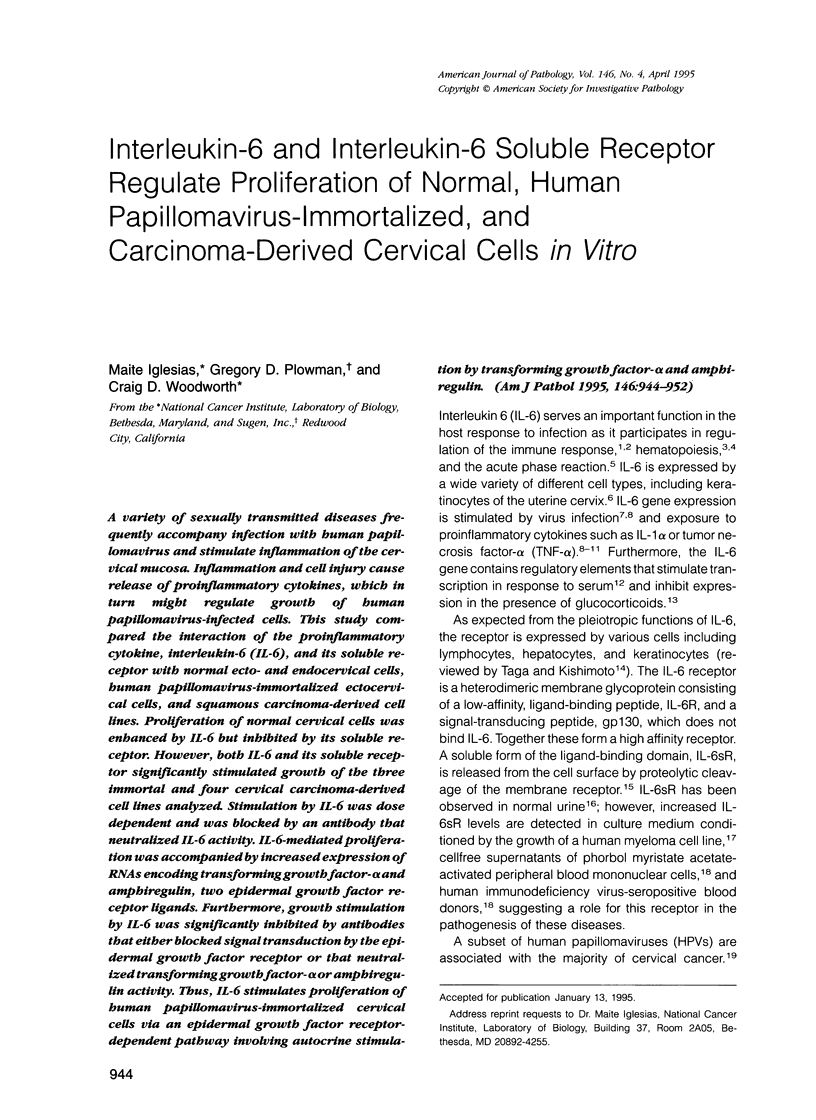
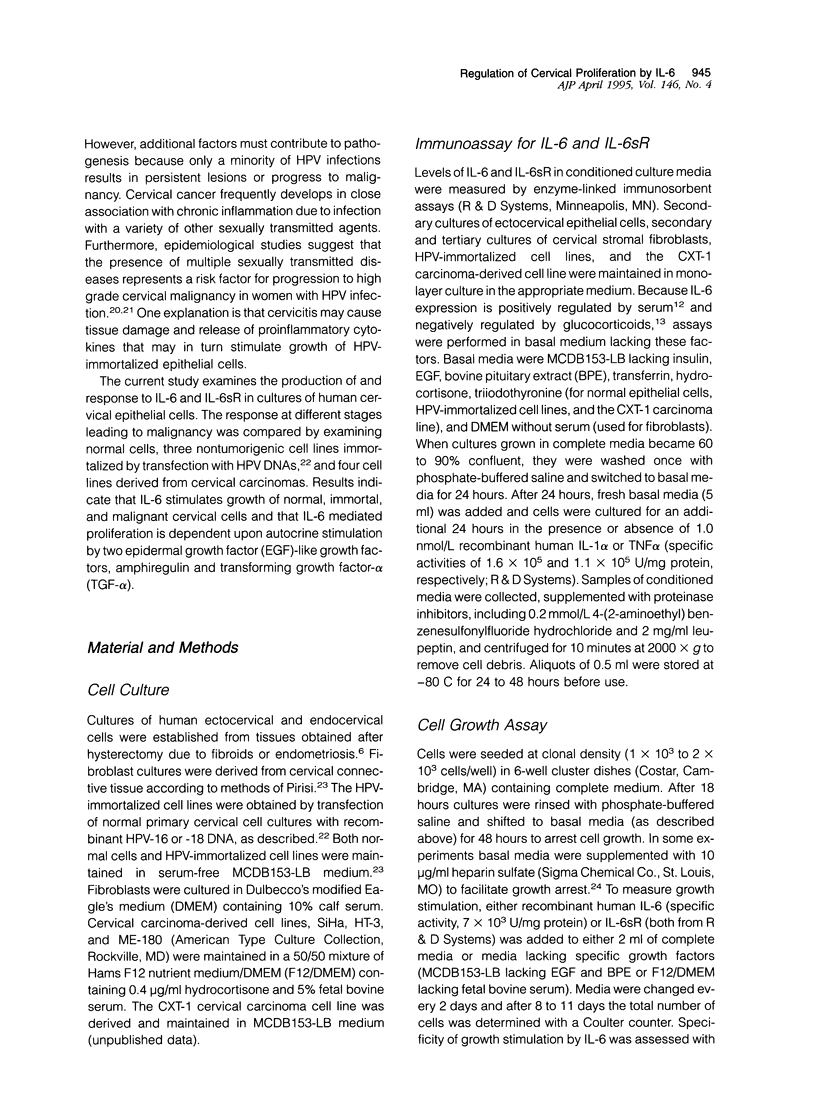
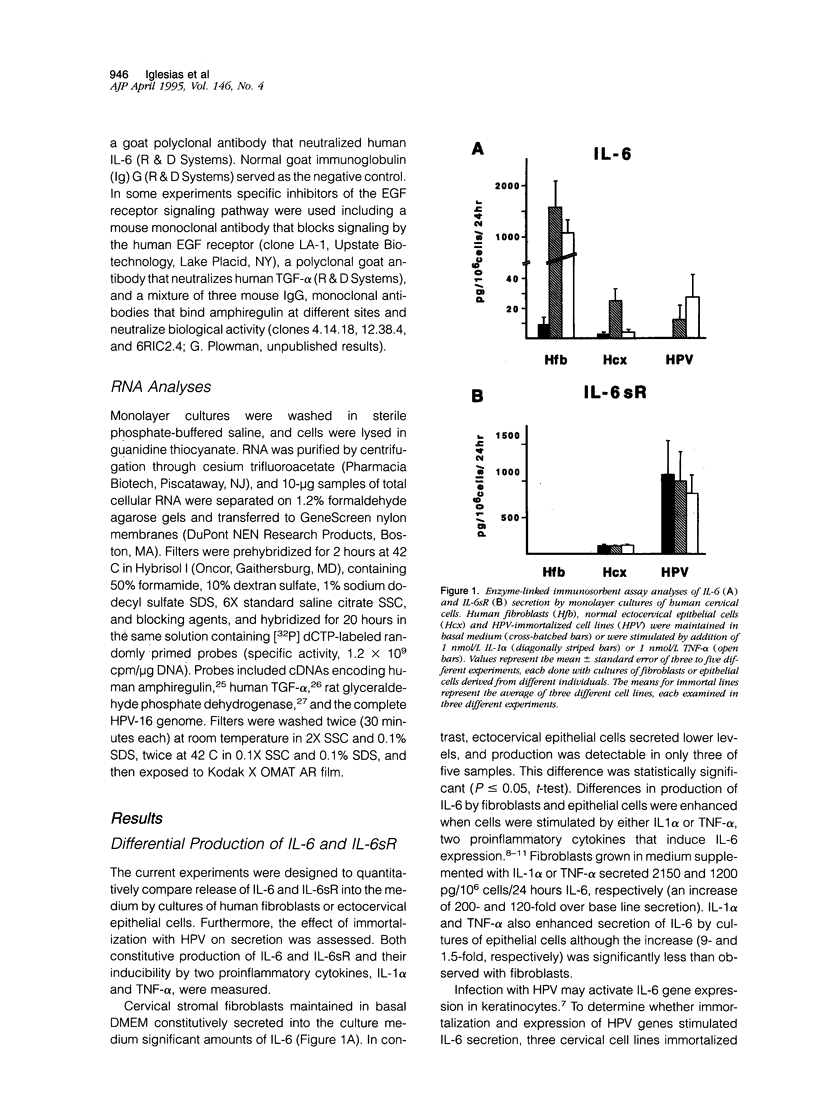
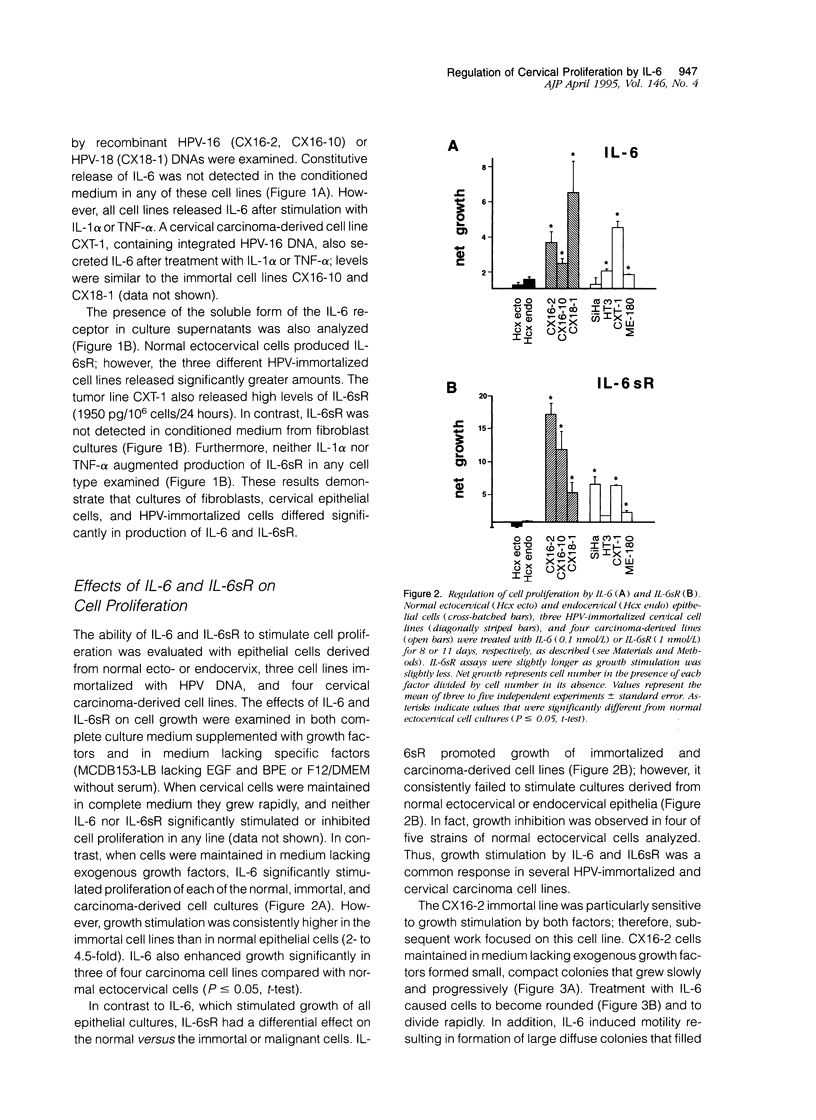
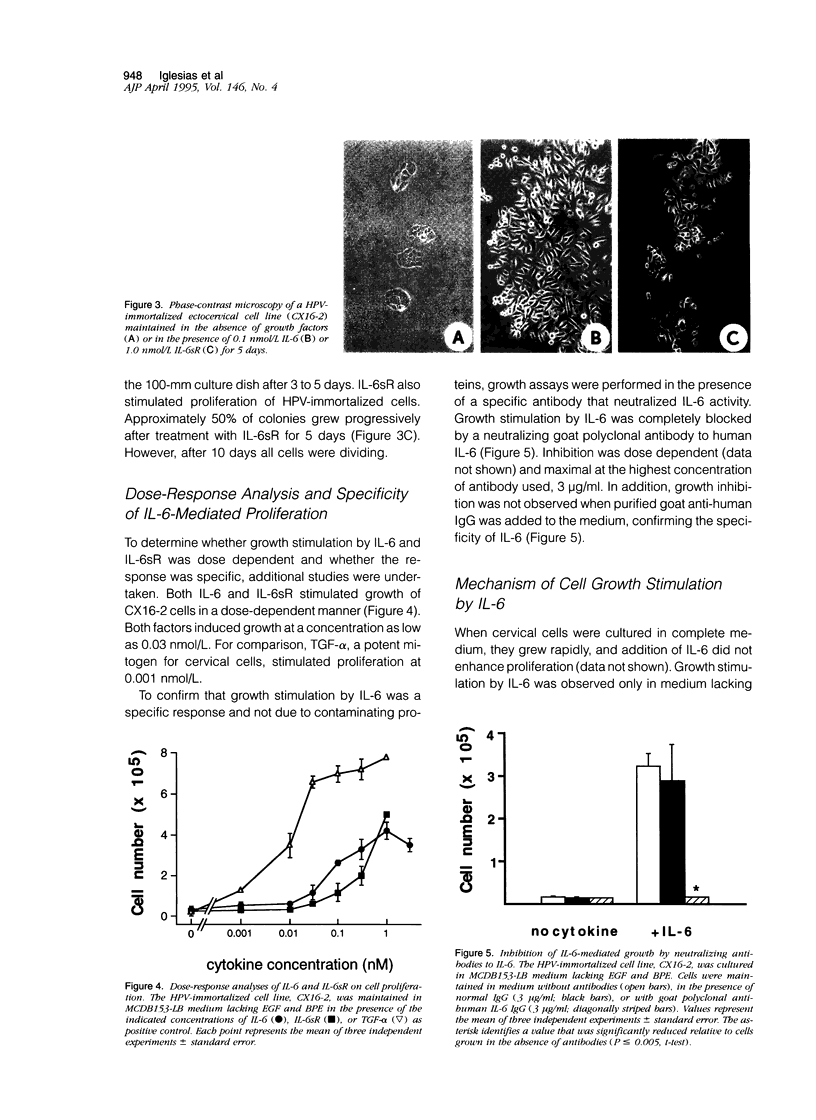

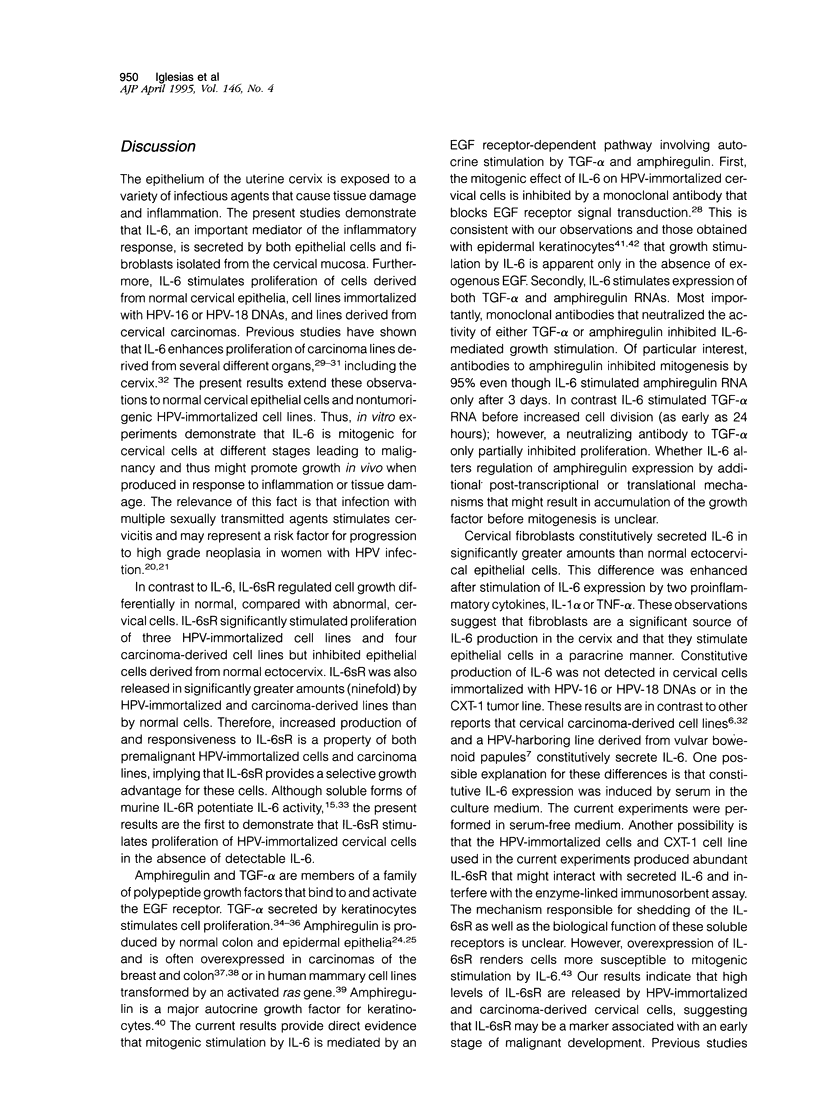


Images in this article
Selected References
These references are in PubMed. This may not be the complete list of references from this article.
- Barrandon Y., Green H. Cell migration is essential for sustained growth of keratinocyte colonies: the roles of transforming growth factor-alpha and epidermal growth factor. Cell. 1987 Sep 25;50(7):1131–1137. doi: 10.1016/0092-8674(87)90179-6. [DOI] [PubMed] [Google Scholar]
- Bruno E., Hoffman R. Effect of interleukin 6 on in vitro human megakaryocytopoiesis: its interaction with other cytokines. Exp Hematol. 1989 Nov;17(10):1038–1043. [PubMed] [Google Scholar]
- Ciardiello F., Kim N., Saeki T., Dono R., Persico M. G., Plowman G. D., Garrigues J., Radke S., Todaro G. J., Salomon D. S. Differential expression of epidermal growth factor-related proteins in human colorectal tumors. Proc Natl Acad Sci U S A. 1991 Sep 1;88(17):7792–7796. doi: 10.1073/pnas.88.17.7792. [DOI] [PMC free article] [PubMed] [Google Scholar]
- Coffey R. J., Jr, Derynck R., Wilcox J. N., Bringman T. S., Goustin A. S., Moses H. L., Pittelkow M. R. Production and auto-induction of transforming growth factor-alpha in human keratinocytes. 1987 Aug 27-Sep 2Nature. 328(6133):817–820. doi: 10.1038/328817a0. [DOI] [PubMed] [Google Scholar]
- Cook P. W., Mattox P. A., Keeble W. W., Pittelkow M. R., Plowman G. D., Shoyab M., Adelman J. P., Shipley G. D. A heparin sulfate-regulated human keratinocyte autocrine factor is similar or identical to amphiregulin. Mol Cell Biol. 1991 May;11(5):2547–2557. doi: 10.1128/mcb.11.5.2547. [DOI] [PMC free article] [PubMed] [Google Scholar]
- Derynck R. Transforming growth factor alpha. Cell. 1988 Aug 26;54(5):593–595. doi: 10.1016/s0092-8674(88)80001-1. [DOI] [PubMed] [Google Scholar]
- Eustace D., Han X., Gooding R., Rowbottom A., Riches P., Heyderman E. Interleukin-6 (IL-6) functions as an autocrine growth factor in cervical carcinomas in vitro. Gynecol Oncol. 1993 Jul;50(1):15–19. doi: 10.1006/gyno.1993.1156. [DOI] [PubMed] [Google Scholar]
- Grossman R. M., Krueger J., Yourish D., Granelli-Piperno A., Murphy D. P., May L. T., Kupper T. S., Sehgal P. B., Gottlieb A. B. Interleukin 6 is expressed in high levels in psoriatic skin and stimulates proliferation of cultured human keratinocytes. Proc Natl Acad Sci U S A. 1989 Aug;86(16):6367–6371. doi: 10.1073/pnas.86.16.6367. [DOI] [PMC free article] [PubMed] [Google Scholar]
- Hirano T., Yasukawa K., Harada H., Taga T., Watanabe Y., Matsuda T., Kashiwamura S., Nakajima K., Koyama K., Iwamatsu A. Complementary DNA for a novel human interleukin (BSF-2) that induces B lymphocytes to produce immunoglobulin. Nature. 1986 Nov 6;324(6092):73–76. doi: 10.1038/324073a0. [DOI] [PubMed] [Google Scholar]
- Honda M., Yamamoto S., Cheng M., Yasukawa K., Suzuki H., Saito T., Osugi Y., Tokunaga T., Kishimoto T. Human soluble IL-6 receptor: its detection and enhanced release by HIV infection. J Immunol. 1992 Apr 1;148(7):2175–2180. [PubMed] [Google Scholar]
- Klein B., Zhang X. G., Jourdan M., Content J., Houssiau F., Aarden L., Piechaczyk M., Bataille R. Paracrine rather than autocrine regulation of myeloma-cell growth and differentiation by interleukin-6. Blood. 1989 Feb;73(2):517–526. [PubMed] [Google Scholar]
- Koutsky L. A., Holmes K. K., Critchlow C. W., Stevens C. E., Paavonen J., Beckmann A. M., DeRouen T. A., Galloway D. A., Vernon D., Kiviat N. B. A cohort study of the risk of cervical intraepithelial neoplasia grade 2 or 3 in relation to papillomavirus infection. N Engl J Med. 1992 Oct 29;327(18):1272–1278. doi: 10.1056/NEJM199210293271804. [DOI] [PubMed] [Google Scholar]
- Krueger J. G., Krane J. F., Carter D. M., Gottlieb A. B. Role of growth factors, cytokines, and their receptors in the pathogenesis of psoriasis. J Invest Dermatol. 1990 Jun;94(6 Suppl):135S–140S. doi: 10.1111/1523-1747.ep12876121. [DOI] [PubMed] [Google Scholar]
- Lahm H., Petral-Malec D., Yilmaz-Ceyhan A., Fischer J. R., Lorenzoni M., Givel J. C., Odartchenko N. Growth stimulation of a human colorectal carcinoma cell line by interleukin-1 and -6 and antagonistic effects of transforming growth factor beta 1. Eur J Cancer. 1992;28A(11):1894–1899. doi: 10.1016/0959-8049(92)90031-v. [DOI] [PubMed] [Google Scholar]
- LeJeune S., Leek R., Horak E., Plowman G., Greenall M., Harris A. L. Amphiregulin, epidermal growth factor receptor, and estrogen receptor expression in human primary breast cancer. Cancer Res. 1993 Aug 1;53(15):3597–3602. [PubMed] [Google Scholar]
- Lowy D. R., Kirnbauer R., Schiller J. T. Genital human papillomavirus infection. Proc Natl Acad Sci U S A. 1994 Mar 29;91(7):2436–2440. doi: 10.1073/pnas.91.7.2436. [DOI] [PMC free article] [PubMed] [Google Scholar]
- Malejczyk J., Malejczyk M., Urbanski A., Köck A., Jablonska S., Orth G., Luger T. A. Constitutive release of IL6 by human papillomavirus type 16 (HPV16)-harboring keratinocytes: a mechanism augmenting the NK-cell-mediated lysis of HPV-bearing neoplastic cells. Cell Immunol. 1991 Aug;136(1):155–164. doi: 10.1016/0008-8749(91)90390-w. [DOI] [PubMed] [Google Scholar]
- Miki S., Iwano M., Miki Y., Yamamoto M., Tang B., Yokokawa K., Sonoda T., Hirano T., Kishimoto T. Interleukin-6 (IL-6) functions as an in vitro autocrine growth factor in renal cell carcinomas. FEBS Lett. 1989 Jul 3;250(2):607–610. doi: 10.1016/0014-5793(89)80805-1. [DOI] [PubMed] [Google Scholar]
- Müllberg J., Schooltink H., Stoyan T., Günther M., Graeve L., Buse G., Mackiewicz A., Heinrich P. C., Rose-John S. The soluble interleukin-6 receptor is generated by shedding. Eur J Immunol. 1993 Feb;23(2):473–480. doi: 10.1002/eji.1830230226. [DOI] [PubMed] [Google Scholar]
- Nakajima T., Yamamoto S., Cheng M., Yasukawa K., Hirano T., Kishimoto T., Tokunaga T., Honda M. Soluble interleukin-6 receptor is released from receptor-bearing cell lines in vitro. Jpn J Cancer Res. 1992 Apr;83(4):373–378. doi: 10.1111/j.1349-7006.1992.tb00117.x. [DOI] [PMC free article] [PubMed] [Google Scholar]
- Normanno N., Selvam M. P., Qi C. F., Saeki T., Johnson G., Kim N., Ciardiello F., Shoyab M., Plowman G., Brandt R. Amphiregulin as an autocrine growth factor for c-Ha-ras- and c-erbB-2-transformed human mammary epithelial cells. Proc Natl Acad Sci U S A. 1994 Mar 29;91(7):2790–2794. doi: 10.1073/pnas.91.7.2790. [DOI] [PMC free article] [PubMed] [Google Scholar]
- Novick D., Engelmann H., Wallach D., Rubinstein M. Soluble cytokine receptors are present in normal human urine. J Exp Med. 1989 Oct 1;170(4):1409–1414. doi: 10.1084/jem.170.4.1409. [DOI] [PMC free article] [PubMed] [Google Scholar]
- Ogawa M., Clark S. C. Synergistic interaction between interleukin-6 and interleukin-3 in support of stem cell proliferation in culture. Blood Cells. 1988;14(2-3):329–337. [PubMed] [Google Scholar]
- Partridge M., Chantry D., Turner M., Feldmann M. Production of interleukin-1 and interleukin-6 by human keratinocytes and squamous cell carcinoma cell lines. J Invest Dermatol. 1991 May;96(5):771–776. doi: 10.1111/1523-1747.ep12471723. [DOI] [PubMed] [Google Scholar]
- Piechaczyk M., Blanchard J. M., Marty L., Dani C., Panabieres F., El Sabouty S., Fort P., Jeanteur P. Post-transcriptional regulation of glyceraldehyde-3-phosphate-dehydrogenase gene expression in rat tissues. Nucleic Acids Res. 1984 Sep 25;12(18):6951–6963. doi: 10.1093/nar/12.18.6951. [DOI] [PMC free article] [PubMed] [Google Scholar]
- Piepkorn M., Lo C., Plowman G. Amphiregulin-dependent proliferation of cultured human keratinocytes: autocrine growth, the effects of exogenous recombinant cytokine, and apparent requirement for heparin-like glycosaminoglycans. J Cell Physiol. 1994 Apr;159(1):114–120. doi: 10.1002/jcp.1041590115. [DOI] [PubMed] [Google Scholar]
- Plowman G. D., Green J. M., McDonald V. L., Neubauer M. G., Disteche C. M., Todaro G. J., Shoyab M. The amphiregulin gene encodes a novel epidermal growth factor-related protein with tumor-inhibitory activity. Mol Cell Biol. 1990 May;10(5):1969–1981. doi: 10.1128/mcb.10.5.1969. [DOI] [PMC free article] [PubMed] [Google Scholar]
- Ray A., Sassone-Corsi P., Sehgal P. B. A multiple cytokine- and second messenger-responsive element in the enhancer of the human interleukin-6 gene: similarities with c-fos gene regulation. Mol Cell Biol. 1989 Dec;9(12):5537–5547. doi: 10.1128/mcb.9.12.5537. [DOI] [PMC free article] [PubMed] [Google Scholar]
- Rosenthal A., Lindquist P. B., Bringman T. S., Goeddel D. V., Derynck R. Expression in rat fibroblasts of a human transforming growth factor-alpha cDNA results in transformation. Cell. 1986 Jul 18;46(2):301–309. doi: 10.1016/0092-8674(86)90747-6. [DOI] [PubMed] [Google Scholar]
- Saito T., Yasukawa K., Suzuki H., Futatsugi K., Fukunaga T., Yokomizo C., Koishihara Y., Fukui H., Ohsugi Y., Yawata H. Preparation of soluble murine IL-6 receptor and anti-murine IL-6 receptor antibodies. J Immunol. 1991 Jul 1;147(1):168–173. [PubMed] [Google Scholar]
- Sato J. D., Kawamoto T., Le A. D., Mendelsohn J., Polikoff J., Sato G. H. Biological effects in vitro of monoclonal antibodies to human epidermal growth factor receptors. Mol Biol Med. 1983 Dec;1(5):511–529. [PubMed] [Google Scholar]
- Schmauz R., Okong P., de Villiers E. M., Dennin R., Brade L., Lwanga S. K., Owor R. Multiple infections in cases of cervical cancer from a high-incidence area in tropical Africa. Int J Cancer. 1989 May 15;43(5):805–809. doi: 10.1002/ijc.2910430511. [DOI] [PubMed] [Google Scholar]
- Smyth M. J., Ortaldo J. R., Bere W., Yagita H., Okumura K., Young H. A. IL-2 and IL-6 synergize to augment the pore-forming protein gene expression and cytotoxic potential of human peripheral blood T cells. J Immunol. 1990 Aug 15;145(4):1159–1166. [PubMed] [Google Scholar]
- Van Damme J., Opdenakker G. Interaction of interferons with skin reactive cytokines: from interleukin-1 to interleukin-8. J Invest Dermatol. 1990 Dec;95(6 Suppl):90S–93S. doi: 10.1111/1523-1747.ep12874825. [DOI] [PubMed] [Google Scholar]
- Woodworth C. D., Bowden P. E., Doniger J., Pirisi L., Barnes W., Lancaster W. D., DiPaolo J. A. Characterization of normal human exocervical epithelial cells immortalized in vitro by papillomavirus types 16 and 18 DNA. Cancer Res. 1988 Aug 15;48(16):4620–4628. [PubMed] [Google Scholar]
- Woodworth C. D., Simpson S. Comparative lymphokine secretion by cultured normal human cervical keratinocytes, papillomavirus-immortalized, and carcinoma cell lines. Am J Pathol. 1993 May;142(5):1544–1555. [PMC free article] [PubMed] [Google Scholar]
- Yoshizaki K., Nishimoto N., Matsumoto K., Tagoh H., Taga T., Deguchi Y., Kuritani T., Hirano T., Hashimoto K., Okada N. Interleukin 6 and expression of its receptor on epidermal keratinocytes. Cytokine. 1990 Sep;2(5):381–387. doi: 10.1016/1043-4666(90)90069-6. [DOI] [PubMed] [Google Scholar]
- Zanker B., Walz G., Wieder K. J., Strom T. B. Evidence that glucocorticosteroids block expression of the human interleukin-6 gene by accessory cells. Transplantation. 1990 Jan;49(1):183–185. doi: 10.1097/00007890-199001000-00040. [DOI] [PubMed] [Google Scholar]
- Zhang Y. H., Lin J. X., Vilcek J. Interleukin-6 induction by tumor necrosis factor and interleukin-1 in human fibroblasts involves activation of a nuclear factor binding to a kappa B-like sequence. Mol Cell Biol. 1990 Jul;10(7):3818–3823. doi: 10.1128/mcb.10.7.3818. [DOI] [PMC free article] [PubMed] [Google Scholar]




